Whether you have just seen a black and yellow snake in the neighborhood and wondering what it is, or you are looking to get a black and yellow snake as a pet for yourself, you have come to the right place.
There are thousands of snake species in the US, and keeping track even of the common ones in your area alone can be quite daunting, which is why I’ve written this guide for you.
So, let’s start with the most common black and yellow snakes:
- Rosy Boa
- Eastern Hognose Snake
- Garter Snake
- Plains Garter Snake
- Scarlet Kingsnake
- California Kingsnake
- Common Kingsnake
- Easter Ribbon Snake
- Striped Racer
- Pine Snake
- Ring-necked Snake
- Yellow Rat Snake
- Western Shovelnose Snake
- Yellow-Bellied Sea Snake
- Gold-ringed Cat Snake (Mangrove Snake)
- Eastern Coral Snake
- Salt Marsh Snake (Gulf Snake)
- The Yellow and Black Branded Krait
- Laotian Wolf Snake
- Wagler’s Pit Viper
- Juvenile King Cobra
- Golden Tree Snake
- Mojave Rattle Snake
- Timber Rattle Snake
In this guide, I’m going to take you through how to identify each of these snakes, what are the fundamentals you should know, and whether you should worry about these snakes.
Before we begin, I would like to remind you that while a very small percentage of snakes are actually venomous, all snakes do bite, and they do it the moment they feel threatened. Snakes are not dogs or cats, please don’t approach one on the street, and try to keep your pets away.
Okay, so let’s get to it.
Contents
24 Black and Yellow Snakes
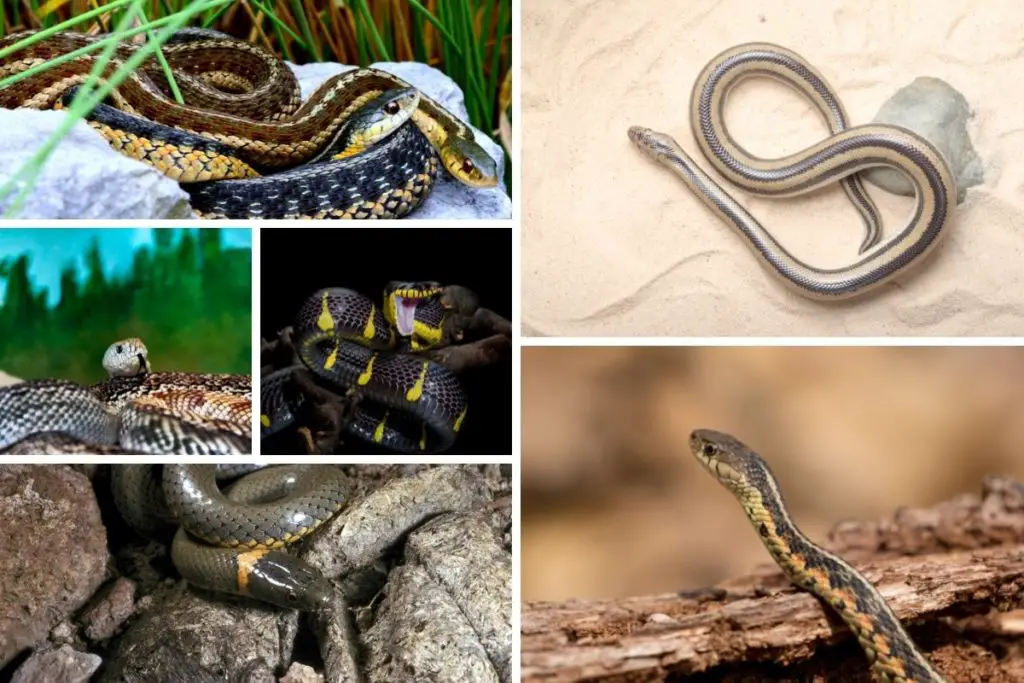
There are probably more than 24 black and yellow snakes out there (there are more than 3,700 species of snakes after all), but these are the ones you are most likely to counter.
This list is in no particular order, and I will try to keep things as simple as possible for each of these snakes.
You should also know that I have a section at the end explaining some of the terms I’ll use to describe the appearance of some of these snakes, so feel free to scroll to it if you don’t totally get what I mean by a certain word or description.
Okay okay, let’s not waste any more time and get to it.
Rosy Boa
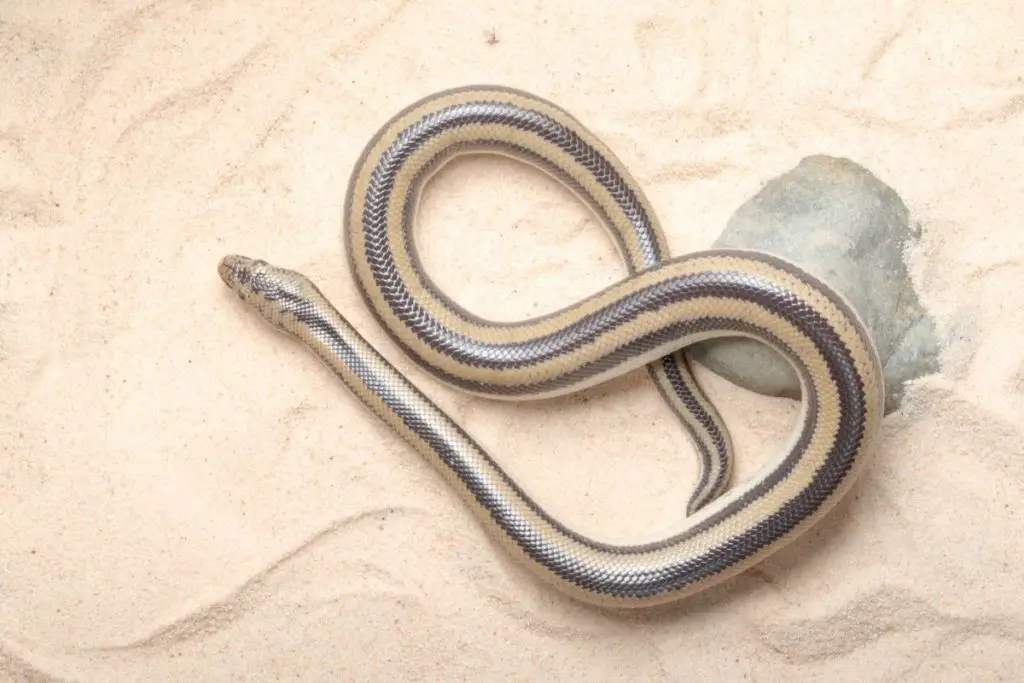
- Size: Up to 3.5 feet.
- Natural Habitat: Deserts and sparsely vegetated places with rocks they can use for cover.
- Diet: Mostly small mammals but they can also consume small lizards and birds.
- Venomous: No.
Rosy boas are wonderful pets! They’re calm, non-aggressive, tiny, and come in a variety of hues. They’re not aggressive at all and are rather docile. If disturbed, a rosy boa will curl itself up into a ball. Their maximum length is typically 3.5 feet long and they weigh very little.
Rosy boas come in a rainbow of colors, including whitish-cream with black, orange, or pink-red stripes, smokey silver with olive stripes, and speckled or mottled. Some are dotted or mottled while others have clean, thin lines.
Rosy Boas can normally be found in Northern Mexico and southwest of the United States.
Eastern Hognose Snake
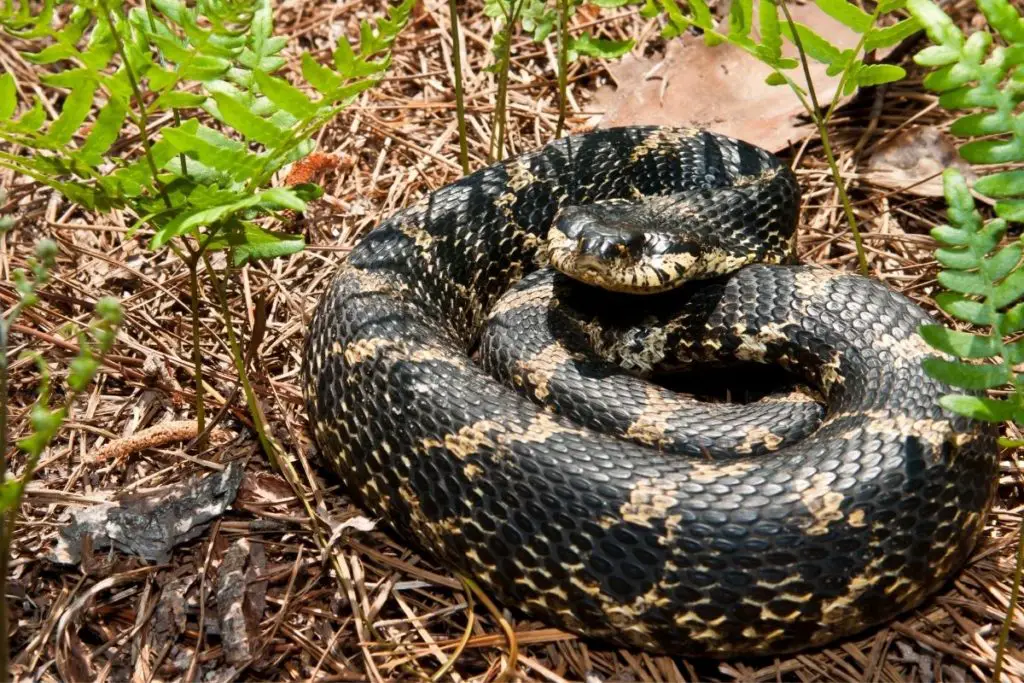
- Size: 22-33 Inches.
- Natural Habitat: Florida, Texas, Minnesota, Ontario, and Quebec.
- Diet: Mainly toads, but they will also eat insects, frogs, and even smaller snakes from other species.
- Venomous: No.
The eastern hognose is a popular domestic pet since it is docile and may be kept in a cage. They are non-venomous and beautiful, with a typical length of 20-33 inches (45 cm).
This snake has a blunt, tapered snout with a point at the end of a thick-bodied body—it’s hefty and solid and it’s where it gets its name.
The coloration of this snake ranges from bright yellow to intense orange, red-brown, olive, and tan to brown or grey. Brown or black irregular patches cover the snake from head to tail.
Garter Snake
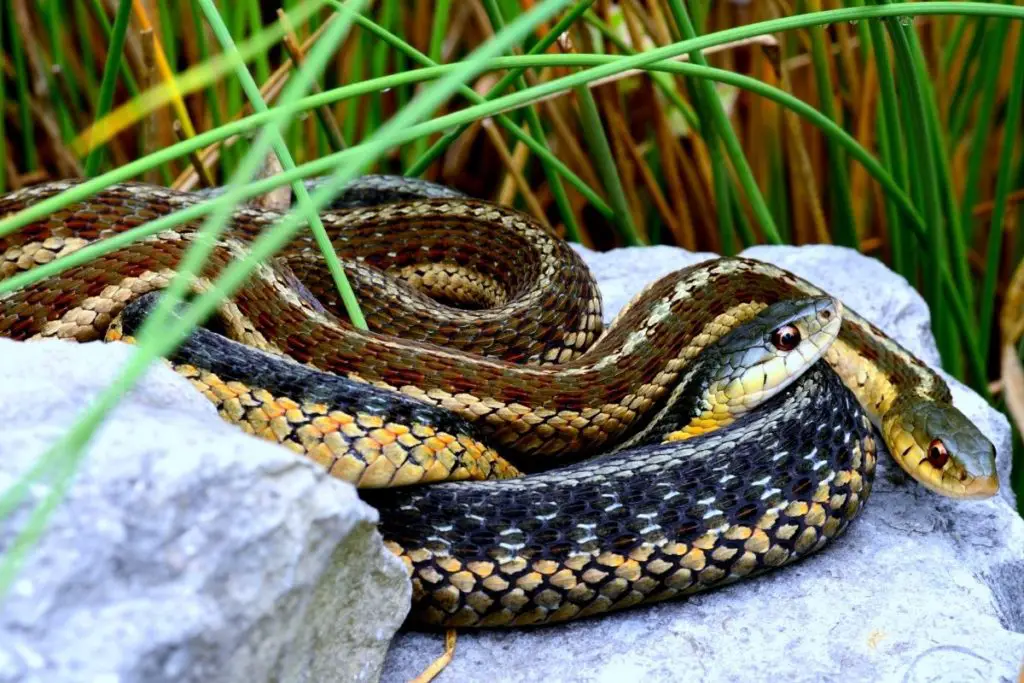
- Size: 18-55 inches.
- Natural Habitat: Common throughout the US (including Alaska) and is very common in Yellowstone National Park
- Diet: Anything that’s small enough for them to swallow, including bird eggs, birds, amphibians, rodents, lizards, and fish.
- Venomous: Mildly venomous, not harmful to humans.
Garter snakes weigh from 3-8 ounces and range in length from 18 inches to over four feet. They produce neurotoxins, but they do have the capacity to harm people—only rats and frogs, which means they’re only mildly venomous.
A garter snake bite will only cause bruising, swelling, or a case of ophidiophobia (snake phobia), still, they’re popular as pets
They are one of the most common snake species in North America and can be found in every state except Hawaii. They are also very common in Yellowstone National Park, where they live near water.
These snakes are extremely colorful and luminous! They have intricate splotchy patterns and yellow or white bellies.
Plains Garter Snake

- Size: 22-33 inches.
- Natural Habitat: Everywhere from Texas to Canada.
- Diet: Similar to the garter snakes.
- Venomous: Mildly venomous – not harmful to humans.
The plains garter snake’s mild venom isn’t harmful to humans, but be aware of a bite. They make great pets due to their small size and low cost of care; they reach 23-30 inches in length and weigh about 5 oz.
What is most special about plains garter snakes is their ability to tolerate cold weather and heights, so if you live somewhere cold and you want a snake that can handle the cold better, this could be the one for you.
Scarlet Kingsnake
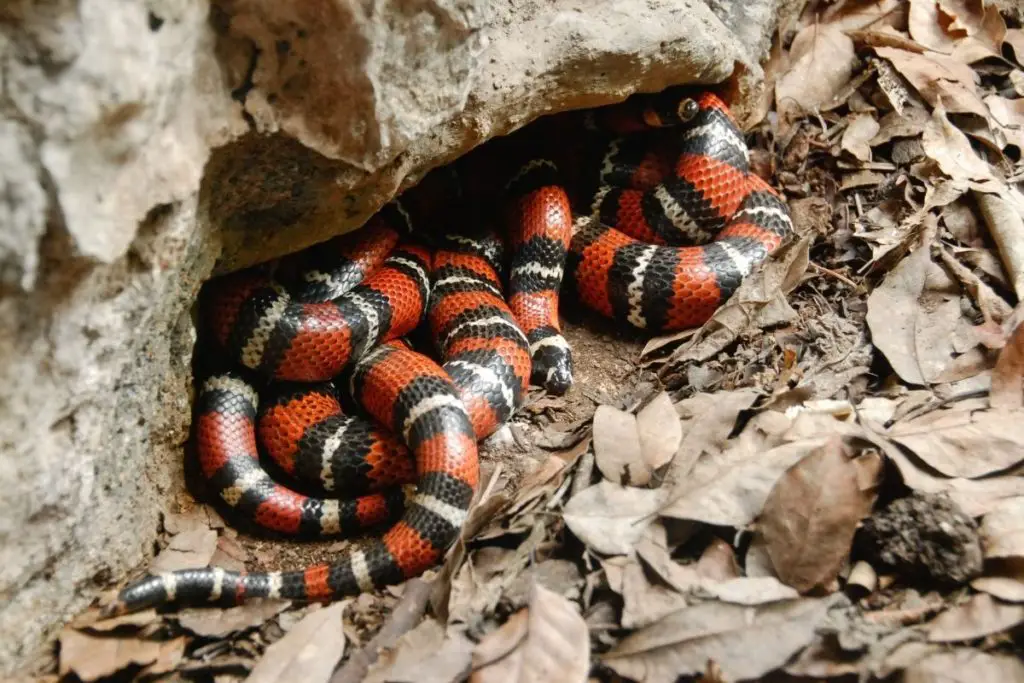
- Size: Up to 2 feet.
- Natural Habitat: New Jersey to Louisiana (basically everywhere in the southeastern US)
- Diet: Rodents, small lizards, and smaller snakes of other species.
- Venomous: No.
The scarlet kingsnake is suitable as a pet snake. It has a mild bite, but it may be readily startled. It is active mostly after dark, so an evening of play is in store! It’s a little snake that measures less than 2 feet long and weighs about 2-3 pounds.
The scarlet kingsnake is quite mesmerizing to look at with its thick alternating rings in black, yellow, and red.
Although they are non-venomous, the scarlet king snake’s confusion with coral snakes is beneficial from a predator avoidance perspective. ‘If red touches yellow, it can kill. a fellow’.
California Kingsnake

- Size: up to 3.5 feet.
- Natural Habitat: California (duh!)
- Diet: Similar to other kingsnakes.
- Venomous: No.
The California kingsnakes are smaller than their relatives, with a length of about 3.5 feet and a weight of 50 ounces. They are also non-venomous, which makes them ideal to keep as pets because they’re docile and easy to handle.
The kingsnakes in this group have a blackish ground with yellow-white markings. These markings can take the shape of might horizontal bands or vertical stripes.
They prefer cooler climates, so they can be found in the Sierra Nevada and Tehachapi mountain ranges, which rise to 7,000 feet in height above sea level. The view from the ground consists of shrubland, marshland, grassland, deserts, and even some suburban areas.
Common Kingsnake

- Size: 3-6 feet.
- Natural Habitat: Open grass areas mostly, but can also live in the desert, streams, canals, swamps, and foothills. They are very adaptable animals.
- Diet: Primarily other snakes, but will also eat rodents, amphibians, and lizards.
- Venomous: No.
Because they are so widespread and can be found almost everywhere, kingsnakes get their name from being “common.” They have been introduced to the Canary Islands, where their population has already grown to 20,000! Maybe it’s better if they renamed it a rabbit snake.
Their appearance makes it easy to distinguish them; A plain, darkish brown to deep blue background color is suitable. The typical kingsnake has few or no chain-like white bands. The stripes on the higher it lives, the thinner they get. Some island kingsnakes are completely black.
There are two very notable things about this snake; its adaptability and immunity to the venom of other snakes. This snake is extremely adaptable and can live almost anywhere, and since it eats other snakes, it’s actually immune to the venom of most other snakes, so it can survive even if a venomous snake bites the common kingsnake while it’s trying to squeeze it to death.
Eastern Ribbon Snake
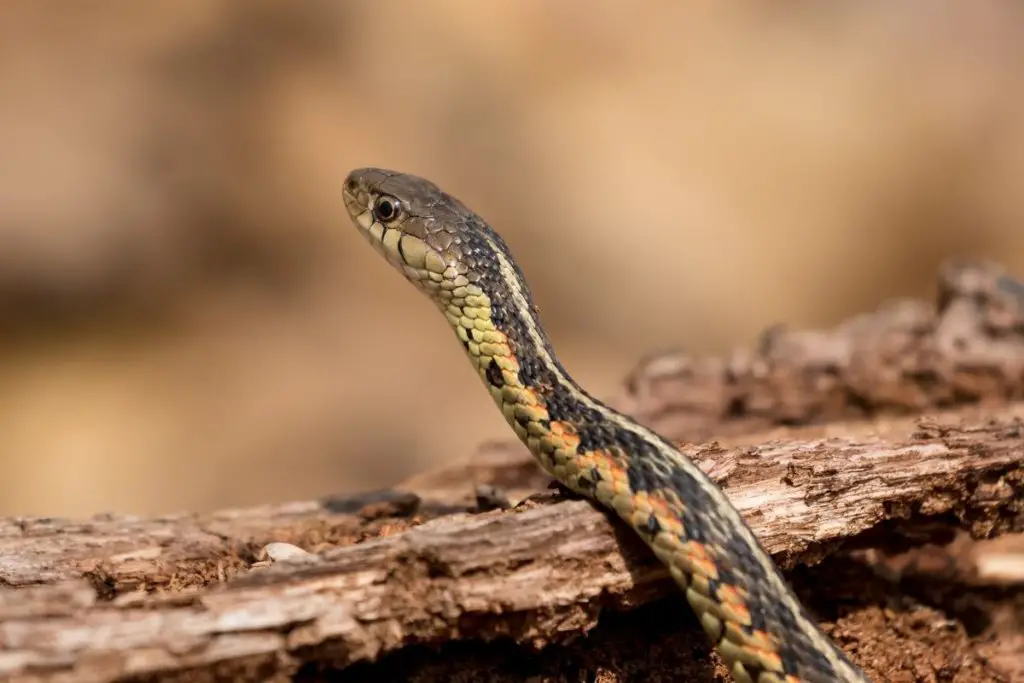
- Size: 16-28 inches.
- Natural Habitat: Near freshwater sources.
- Diet: Small marine animals like frogs, fish, toads, and salamanders.
- Venomous: No.
The eastern ribbon snake is non-venomous. However, if it feels threatened, it will discharge a foul musk from its glands. It’s 7 to 34 inches in length, but on average is about 16 to 28 inches
Because of its thin, streamlined form, the ribbon snake got its name. It can be identified by a bright yellow vertical stripe on the side of its body. Its belly is green-white and its lips are pure white.
Striped Racer
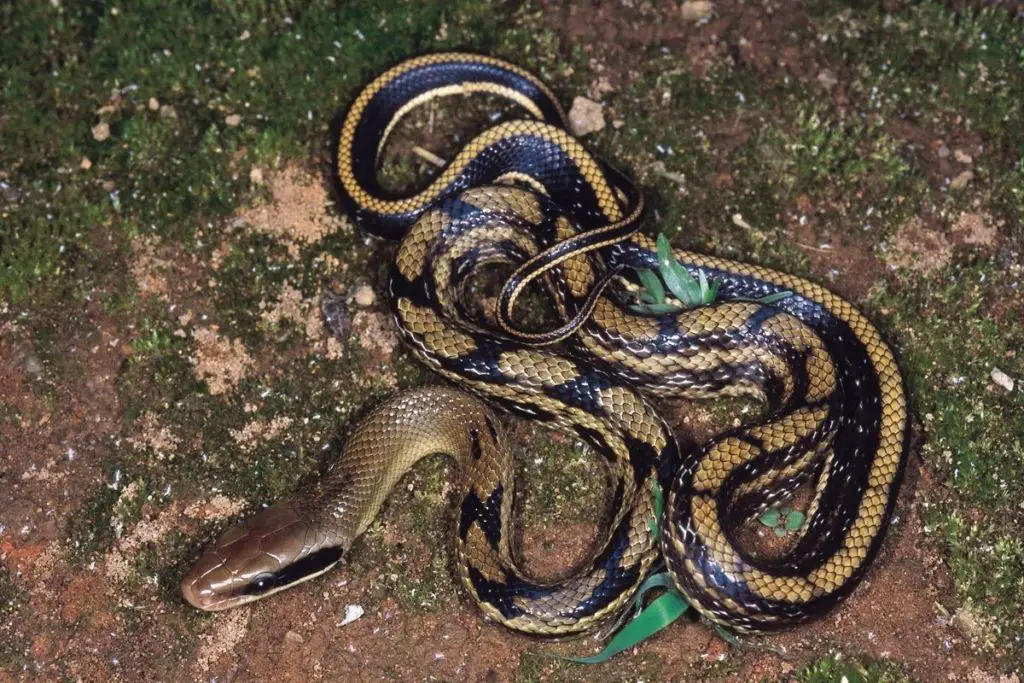
- Size: Up to 4 feet.
- Natural Habitat: In California near Foothills, woodlands, desert scrubs, and anywhere they can find food.
- Diet: Insects, lizards, small mammals,s and birds.
- Venomous: No.
Striped racers prefer to flee than fight, but they are known to be aggressive and easily frightened. Those looking for a first-time pet snake should probably avoid them. They generally reach 3-4 feet in length and weigh up to 5 ounces.
It’s long, thin, black, and yellow-bellied. It also has two long, thin stripes that run along the side of its body. Some say these racing stripes alone can double their speed! (Ha Ha!)
Pine Snake

- Size: Up to 8 feet.
- Natural Habitat: Southeastern US, South California, Georgian, Virginia, New Jersey, Tennessee, and, of course, Florida.
- Diet: Anything they can swallow, including birds, their eggs, lizards, insects, and amphibians.
- Venomous: No.
The Northern pine snake is large and non-venomous. It’s known by many names, including horned snake, bull snake, white gopher snake, or pilot snake.
Overall, the pine snake is an excellent captive that requires little upkeep. Pine snakes, on the other hand, are not for everyone due to their size and need for plenty of areas to move about. They can be rather pushy and messy. So they are not suitable for first-time snake owners.
When approached or threatened, pine snakes rattle their epiglottis, producing a rattling sound. Their rattle is comparable to that of rattlesnakes. Pine snakes are non-venomous and not deadly, yet if they do bite, it can be quite painful.
Ring-neck Snake
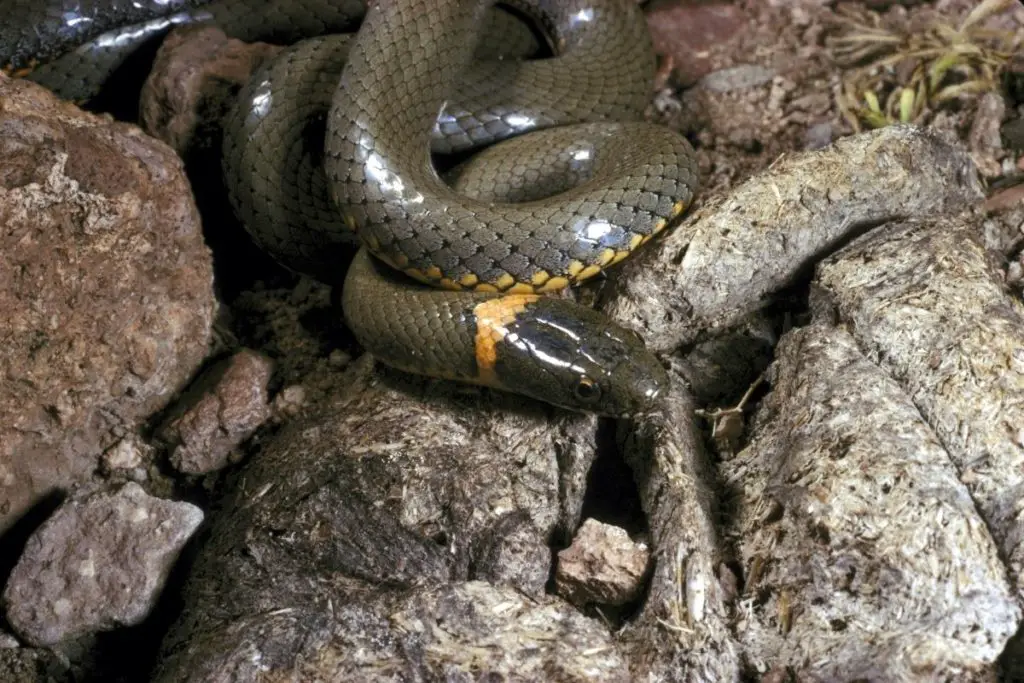
- Size: 15 inches.
- Natural Habitat: All of the US and Mexico.
- Diet: Worms, salamanders, slugs, frogs, and even baby snakes of other species.
- Venomous: Yes, but the venom is too weak for humans.
The single yellow, orange, or bright red line around the neck of this snake stands out dramatically against its dark, smoky, olive-grey, or drab black background color. There are numerous populations that do not have this neckband, which is unusual. Otherwise, patterns include black ventral spotting and basic olive-black.
This is a nocturnal or crepuscular snake that you’re unlikely to see during the day. They are non-venomous, with only little teeth, so they may be handled safely. It’s only 15 inches in length and extremely light in weight.
Yellow Rat Snake
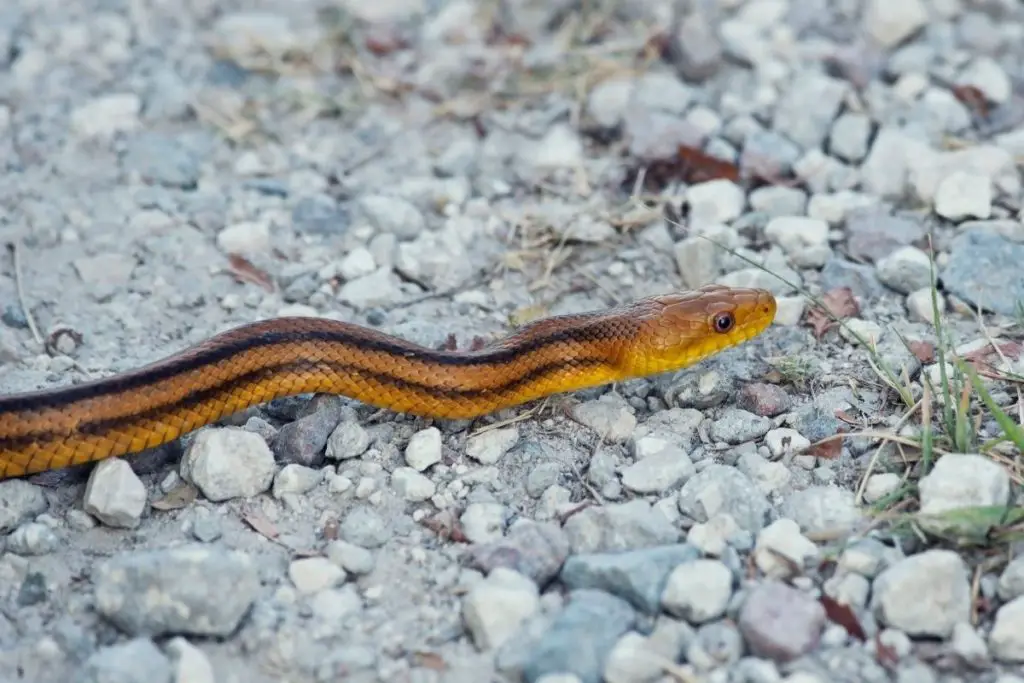
- Size: Between 5 and 7 feet.
- Natural Habitat: Southeastern US.
- Diet: Rodents, birds, and birds’ eggs.
- Venomous: No.
Yellow Rate snakes are non-venomous constrictor snakes. While their bites may be painful, they are quite harmless to humans, but it’s a very different story for rats.
Rat snakes are slender, and their length ranges between 5 and 7 feet. They are not as toxic as they appear, since they can be killed by strangling.
If threatened, they will bite out of fear, which is quite common while feeding. They may also assume a defensive posture where they imitate a branch.
Their coloring is a darkish yellow tinted with orange. Their body has four vertical stripes that run along each side, on the sides of the spine, and down the center. These stripes might be brown, black, or olive.
Western Shovelnose Snake
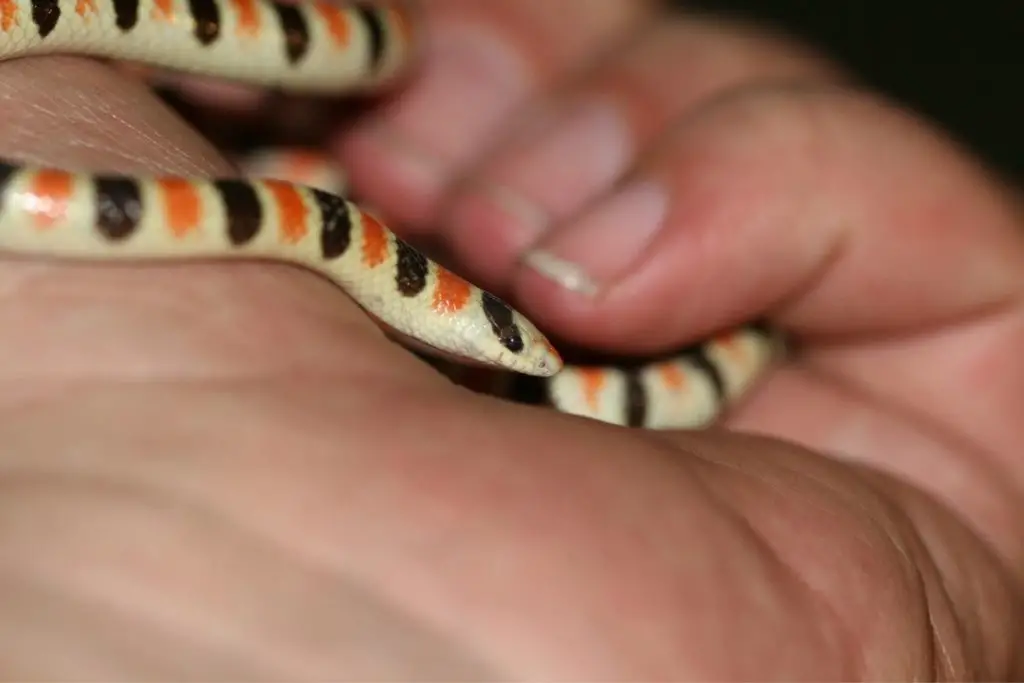
- Size: 1.5 feet.
- Natural Habitat: Deserts.
- Diet: Spiders, insects, centipedes, reptile eggs, and scorpions.
- Venomous: No.
Even though The shovelnose is difficult to feed, it’s still suitable for a pet, but for beginners.
It’s non-venomous, but its saliva has a foul smell. It’s also relatively non-confrontational as it’s known for spending its time buried under the sand. When scared, the western shovelnose will mimic attacks with a tight-mouthed mouth to frighten off its opponent.
As for their looks, these snakes are small, thin, and have smooth scales. Their base color is light cream or yellow, and they have dark brown or black saddles that run down the length of their body.
These saddles sometimes alternate with red and oranges. They may seem like stripes at first glance, but they actually resemble diamonds or kites that span the back.
Yellow-Bellied Sea Snake
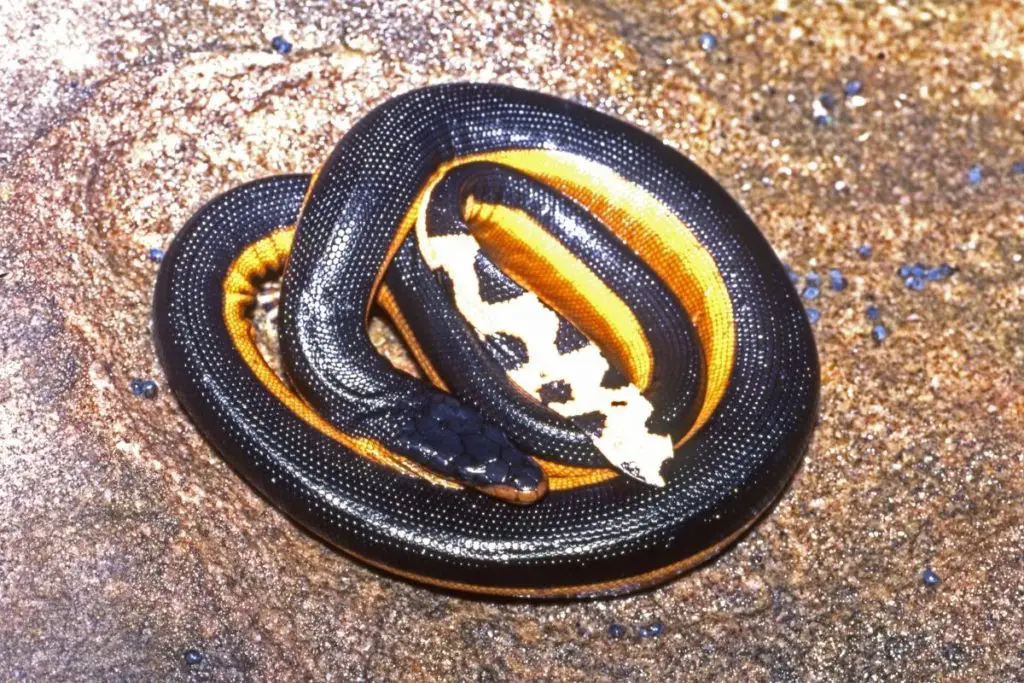
- Size: Up to 3.5 feet.
- Natural Habitat: Indo-specific waters, from Hawaii and California to Southeast Asia, Japan, and Newzealand.
- Diet: Fish
- Venomous: Highly venomous
This creature is not suitable for apartment living. First and foremost, it must be in the water. Second, it is extremely poisonous. Thirdly — OK, there are two reasons why this matters. It weighs approximately 3 ounces and grows up to 3.5 feet long.
This snake has a bright, block-yellow belly and a narrow build with an oar-shaped tail that helps it swim faster. Its top side is jet black.
Gold-ringed Cat snake (Mangrove Snake)
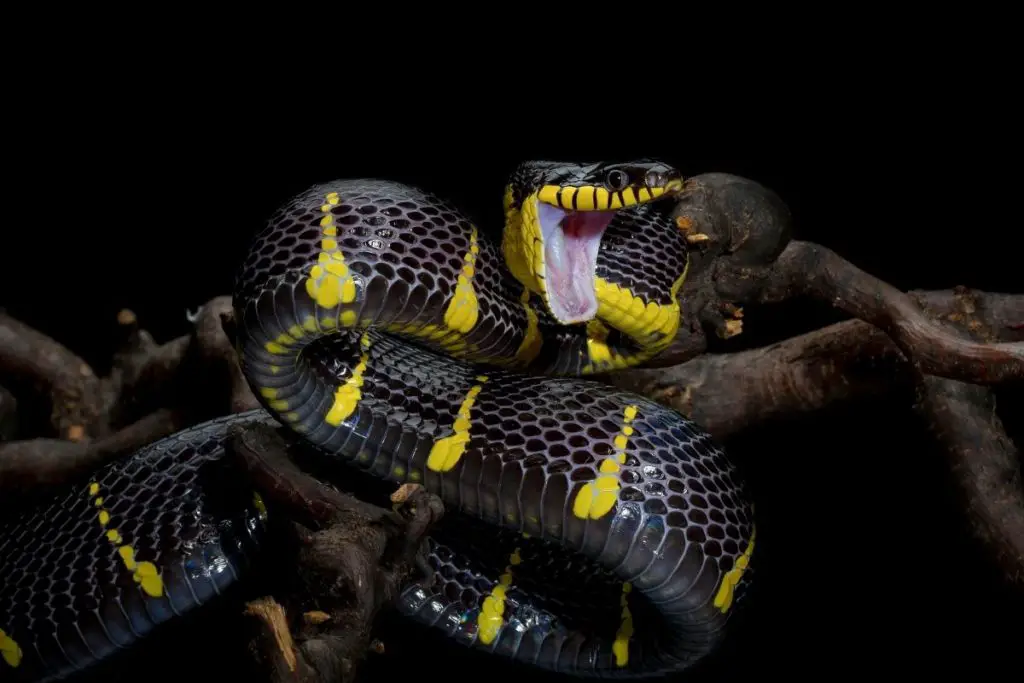
- Size: Up to 8 feet.
- Natural Habitat: Southeast Asia.
- Diet: Reptiles, small mammals, and birds.
- Venomous: Yes, mildly venomous.
Golden-ringed cat snakes or Mangrove snakes are not suitable as pets since they are thought to be rather aggressive toward those who try to catch them.
Even though there have been no documented deaths, these snakes are likely to become aggressive and inclined to bite. They can reach up to 8 feet long and weigh up to 50 pounds when fully grown.
The body is black, glossy, and smooth in appearance. It has a pair of brilliant yellow transverse stripes. The belly is blue-black, dotted with yellow occasionally, and their throat is bright yellow.
Eastern Coral Snake
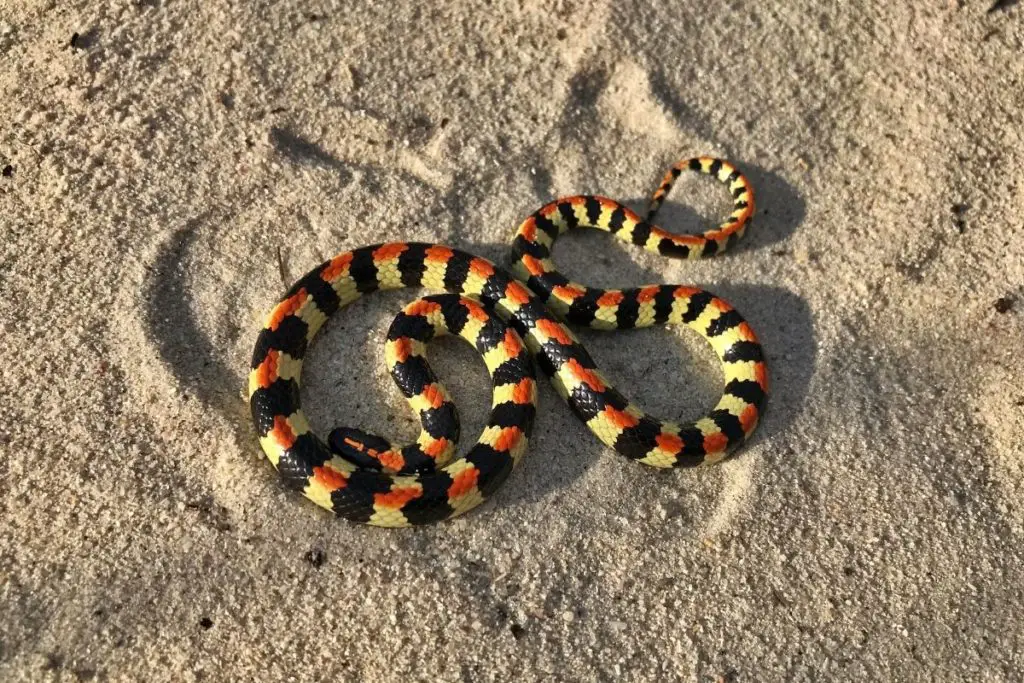
- Size: Up to 31 inches.
- Natural Habitat: North and South Carolina, Florida, Alabama, Louisiana, Georgia, and Mississippi.
- Diet: Lizards, frogs, and smaller snakes.
- Venomous: Very venomous, the second strongest venom in its snake family.
Harlequin coral snakes have the second-strongest venom of all snake species. They are not suitable as pet snakes even though they do not have an effective mechanism to deliver the venom.
They are hesitant to bite, so bites are uncommon. As a result, the antivenom manufacturing process has been halted. That’s even more incentive not to be bitten.
They’re small and slim, with a head that’s slightly less wide than their neck. The top of its head and the end of its snout are black, as is the pattern of alternate transverse rings, which are yellow, black, and red all along its length.
Interestingly enough, they are also known as candy-stick snakes because of their patterns.
Salt Marsh Snake (Gulf Snake)
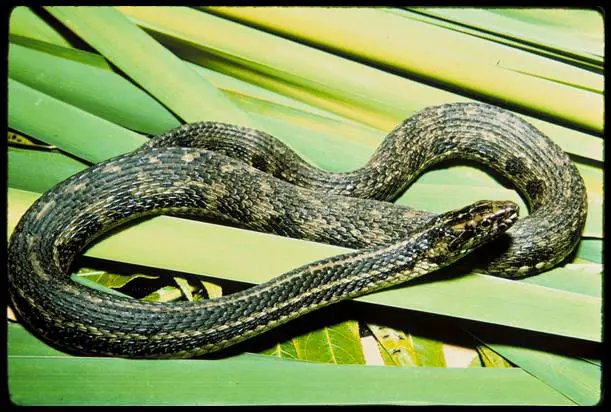
- Size: Up to 30 inches.
- Natural Habitat: Different parts of the US including the Atlantic on the Floridan coast, the Mangrove in different parts of Florida, and the Gulf between South Texas and Florida.
- Diet: Fish and invertebrates.
- Venomous: No, but they are aggressive and bite.
Non-venomous and not particularly aggressive, marsh snakes nevertheless have been known and reported to bite. They can reach a length of 30 inches and are not heavy in weight.
The only striped Nerodia species is the one shown here. It has four stripes on its upper body, two of which are typically brown, two tan or yellow-brown, and two pale brown. Its belly is dark, but it is bifurcated by a bright stripe that runs down the center.
The Yellow and Black Branded Krait
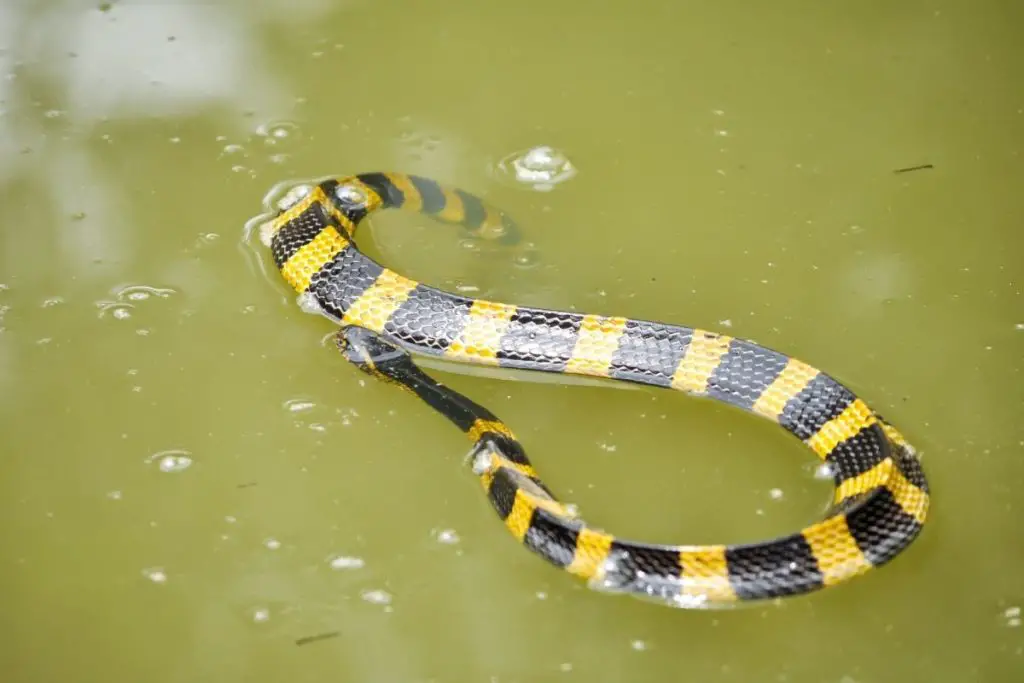
- Size: Up to 6 feet.
- Natural Habitat: East-Asia
- Diet: Fish, frogs, skins, and the eggs of other snakes.
- Venomous: Yes.
The Banded Krait is another example of snakes with black and yellow hues. It belongs to the Elapidae family. It may be found in various East-Asian countries, including India, Southern China, Nepal, Myanmar, Cambodia, Bangladesh, Laos, Vietnam, and Thailand.
Banded kraits have black and yellow bands that alternate along the length of their bodies. They can reach up to 6 feet in length.
The Banded Krait’s venom is neurotoxic, causing dizziness, diarrhea, nausea, and abdominal discomfort. Breathing difficulties can also occur as a result of severe envenomation, leading to death.
Fortunately, it’s considerably less common to get a snake bite from Branded Kaits than many other poisonous snakes in its region.
Laotian Wolf Snake

- Size: Up to 70 cm only.
- Natural Habitat: Southeast Asia
- Diet: Insects, frogs, geckos, and lizards.
- Venomous: No.
The Lao serpent, also known as the Asian carpet snake, is a non-venomous little (70 cm) snake that is native to Southeast Asia and Laos – the country it is named after.
These snakes are generally quiet and uninterested in biting. Laotian wolf snakes are black with bright yellow and white bands down the length of its body.
They are harmless to humans but are not recommended as pets nonetheless.
Wagler’s Pit Viper

- Size: Up to 80 cm.
- Natural Habitat: Thailand.
- Diet: Lizards, birds, and rodents.
- Venomous: Yes, all pit vipers are venomous.
Although not always yellow and black, Tropidolaemus wagleri can have a gorgeous yellow and black form like the one in the picture above. This snake was from Krabi, Thailand.
These are shy snakes, so people don’t encounter these snakes very often.
Juvenile King Cobra
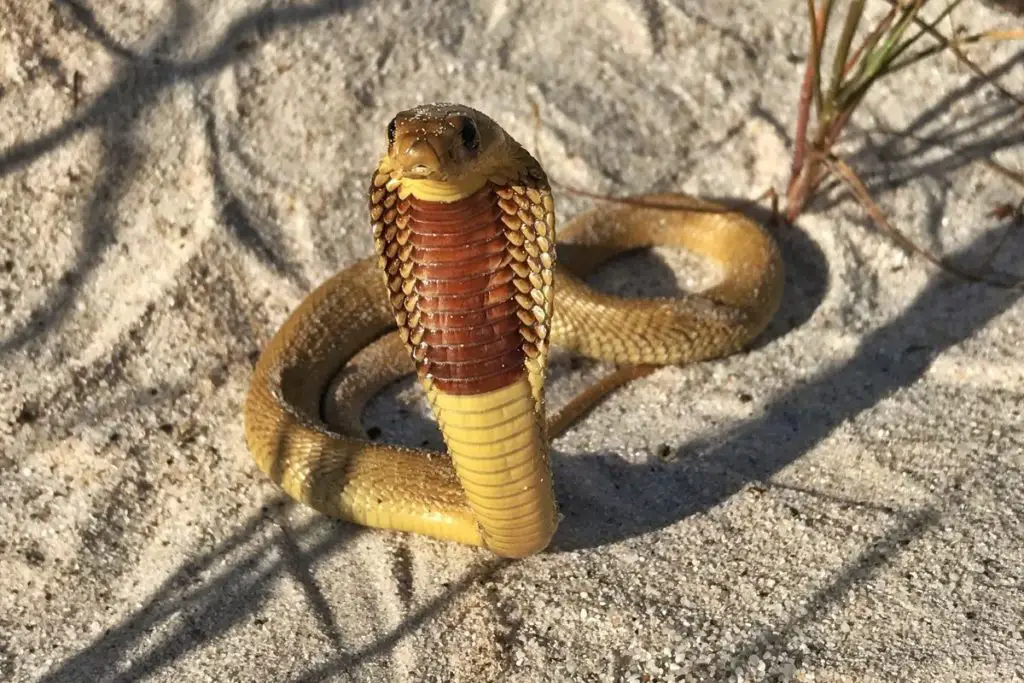
- Size: Up to 50 cm.
- Natural Habitat: Thailand.
- Diet: Anything they can eat, including other snakes, mammals, mice, and rats.
- Venomous: Yes, very.
Some king cobras are yellow and black when they hatch, but become adult coloration after a period of time. The head of one tiny (50cm) newborn King Cobra is shown above.
Even as hatchlings, king cobras are quite dangerous, since their venom is even more poisonous than that of adults.
Golden Tree Snake

- Size: Up to 40 inches.
- Natural Habitat: Thailand, Indonesia, New Guinea, and the Solomon Islands.
- Diet: Anything they can eat; geckos, lizards, bird eggs, small mammals, tadpoles, frogs, skinks, etc.
- Venomous: Yes, mildly venomous.
The Golden Tree Snake is also known as a “yellow and black snake,” although they are usually some shade of very light green and black.
Other snakes have yellow and black hues, but they also include other colors.
Mojave Rattle Snake
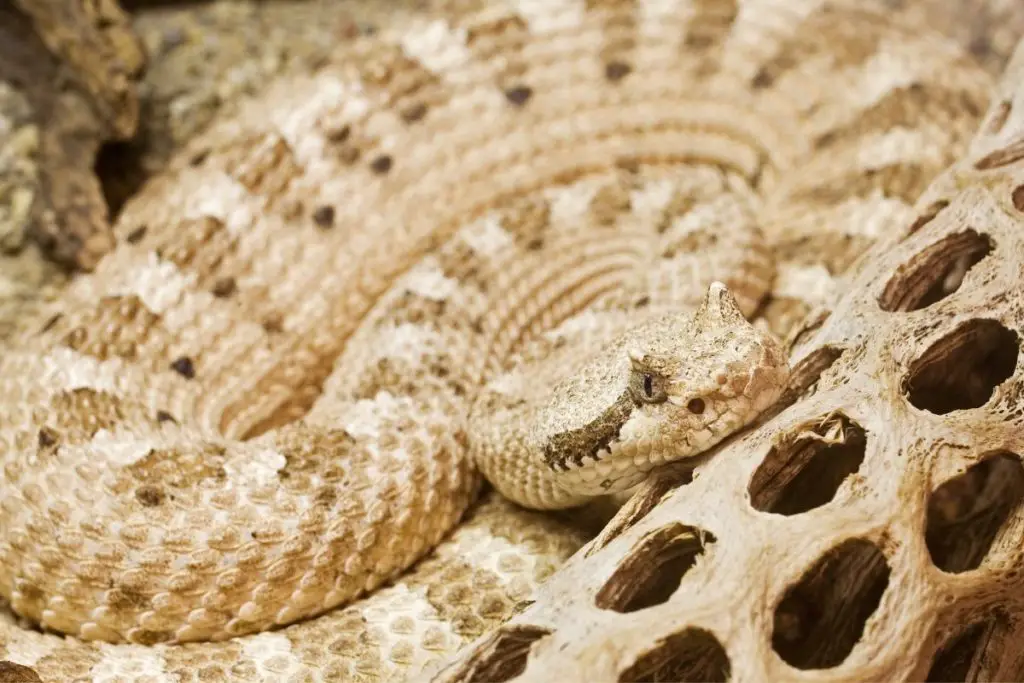
- Size: 2-4 feet.
- Natural Habitat: Texas, Arizona, Nevada, and New Mexico.
- Venomous: Yes, and they are aggressive.
The Mojave Rattlesnake can be found in West Texas. It’s a highly toxic pit viper that may also be found in other states including Arizona, Nevada, and southern New Mexico. It has a yellow tint and is pale black/grey in color.
Timber Rattle Snake
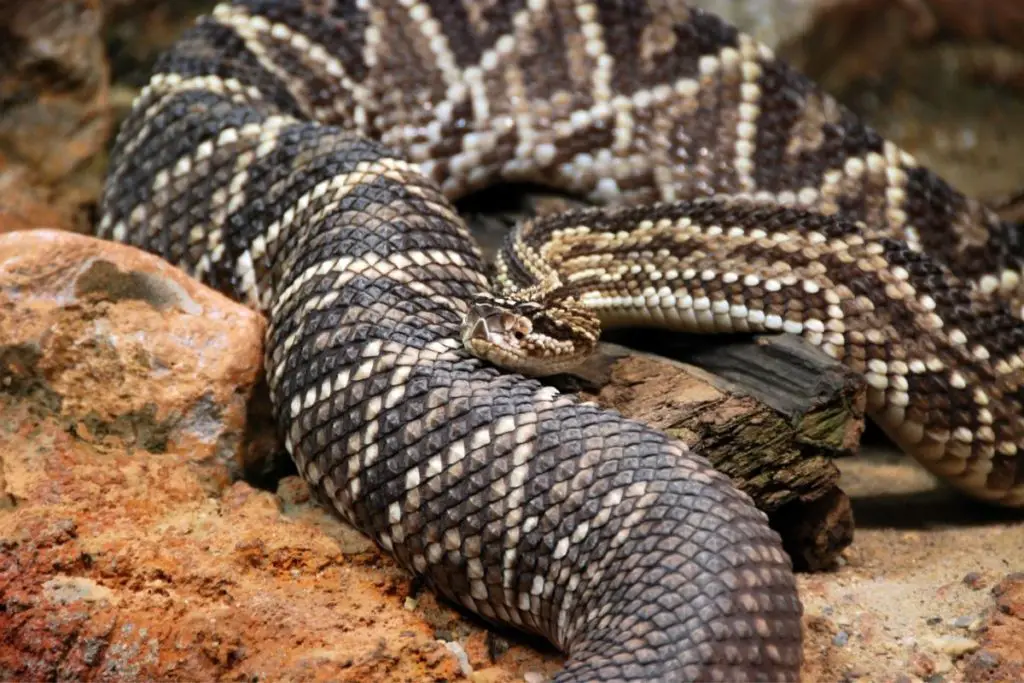
- Size: 30-40 inches.
- Natural Habitat: Rugged terrains.
- Diet: Mainly rodents.
- Venomous: Yes.
The Timber Rattlesnake has a yellowish background and a black tail. This snake’s territory extends across the whole of the United States. It’s poisonous and, if provoked, can be deadly. If you came upon this snake in nature, you’d be crazy to approach it.
Despite its name, it does not generally scale trees. For further information, see this post on “Do snakes Climb” They are a vital part of the food chain, keeping rat numbers in check. It is terrible to consider how much effort has gone into protecting them because humans have relentlessly murdered them.
Are Black and Yellow Snakes Poisonous?
No, most black and yellow snakes are not poisonous. Black and yellow snakes in the American Continent are nonvenomous snakes. The yellow and black banded krait from Thailand is one of the black and yellow snakes that are venomous, but they are naturally wary of humans and try to avoid them. They are also nocturnal.
A bite from the black and yellow banded Krait will get neurotoxins in your blood and will lead to dizziness, vomiting, diarrhea, abdominal pain, and severe envenomation, which is rare, and will cause death.
Snakes in Texas, venomous or not, are a big part of the ecosystem in the state and they play a large role in keeping the ecosystem stable. Snakes are also wary of humans in general and will try to avoid them in general.
However, while humans are not on the menu of snakes, some pets can be (for larger snakes), so it’s important to know how to keep snakes away from your home. One of the ways you can do that is simply using a guard dog, and you can learn about the dogs that can keep snakes away here.
Can Snakes change colors?
Scientists have recently discovered four snake species (to the time of writing) that can indeed change color in the same way a chameleon can, which was something previously thought impossible.
Snakes will usually change color when they are shedding, but this is part of the shedding process and is not done intentionally to camouflage themselves, but these four species of snakes can indeed change their color for camouflage reasons.
Snake Pattern Terms You should know
You may have read some snakes terms that you are not familiar with in this article (or other articles), so let’s quickly explain each of these terms and what they mean:
- Mottled: MEans it’s marked with smears or spots.
- Blotchy: Resembles patchwork. Looks like an uneven, streaky pattern.
- Lateral: Running down its side
- Dorsal: Running down the spin.
- Longitudinal: Running from head to tail lengthways
- Speckles: Flecks of color, usually just one or two per scale.
That’s it, you now can speak snake patterns.
Conclusion
Snakes may not be the most popular animal, but they are vital to the ecosystem. The black and yellow snakes in American Continent are nonvenomous, so if you see one on your property don’t run away screaming!
If you have a black and yellow snake, take a picture and share it with us on Facebook, Twitter, or send it by email and we’ll feature it on the site!
We would love to see your snake photos! And as always, if you found this article helpful, please do feel free to share it!
Helpful Resources
Identifying Venomous and Nonvenomous Snakes in Texas
Texas Poisonous (Venomous) Snakes
A Guide to Snakes of Southeast Texas
If you like this article, please share it!


